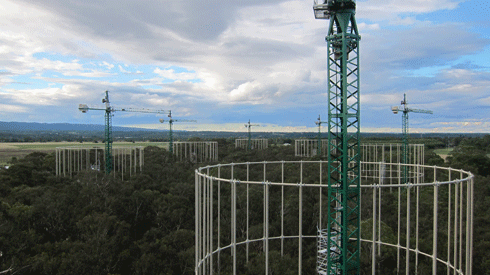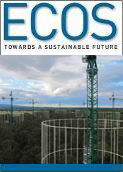
|
Published: 29 October 2012
Mature forest becomes laboratory for outdoor climate change experiment
In what is claimed to be the world’s most complex climate change experiment, scientists have created six 25-metre diameter, nine-storey-high, ring-shaped ‘test tubes’ in bush woodland near the University of Western Sydney (UWS) to measure the effect of increasing CO2 levels on living forests.
Through the Eucalyptus Free Air CO2 Enrichment experiment, or EucFACE, teams of scientists and engineers will expose tracts of bush to elevated concentrations of atmospheric carbon dioxide – similar to those predicted in the next 35 years.
The impact of the higher CO2 levels on everything within the rings – from the genes in plants, insects and microorganisms to growth rates of trees to the function of the entire ecosystem – will be studied.
‘This is the first time a mature forest ecosystem will be exposed to higher CO2 concentrations,’ says principal investigator on the EucFACE, Professor David Ellsworth from the UWS Hawkesbury Institute for the Environment.
‘This experiment will reveal how our Australian bush will react to the inevitable increases in atmospheric concentrations of carbon dioxide. It’s important because we need to know how the changes in the atmosphere could affect the pattern of water used by millions of hectares of bush, how much carbon the bush can lock away and how the ecosystem will adapt to the new conditions.’
The 5-hectare EucFACE site is on a patch of Cumberland woodland scrub on the UWS Hawkesbury campus near Richmond NSW, 60 kilometres from Sydney. The scientists say this serves as a model for typical bush ecosystems in Australia.
At the heart of the experiment is a collection of vertical vent pipes each 28 metres tall and peppered with thousands of holes delivering an extra dose of carbon dioxide. The pipes are arranged in clusters of 32 to form six circles each 25 metres across.
The rings are completely open to the air so that the enclosed vegetation will experience the same temperatures, rainfall and other weather conditions as the surrounding bush. It’s also open to animal and insect migration, which will enable observations of ecological interactions under future atmospheric CO2 levels.
‘We’re not creating another biosphere,’ says Professor Ellsworth. ‘This experiment is focused on the impact of higher levels of atmospheric CO2 on the ecosystem. We have other experiments underway at the University of Western Sydney which look at different aspects of climate change including changing rainfall patterns and higher temperatures.’
Local weather conditions are constantly monitored by scores of sensors in, around and on the rings. The data is used by computers to precisely control the flow of gas into the test rings.
Within the test rings the ambient levels of carbon dioxide will be gradually increased to be 150 parts per million (ppm) above the current average atmospheric concentration of 380 ppm.
‘We don’t want to shock the ecosystem with a sudden increase,’ says Professor Ellsworth. ‘We need to increase the levels faster than is happening in the real world but not so fast as to change the ecosystem overnight.’
Professor Ellsworth and a team of Australian and international scientists will monitor every aspect of the EucFACE site, particularly water use, carbon storage and changes to biodiversity for at least the next five years.
‘This is going to be the most watched patch of bush in Australia,’ says Professor Ellsworth.
Source: UWS




